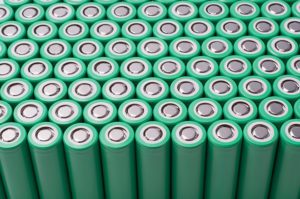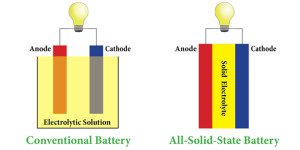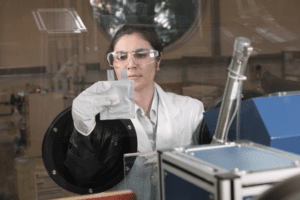Researchers at Tokyo Metropolitan University have developed a new method to make ceramic-based flexible electrolyte sheets for lithium metal batteries. They combined a garnet-type ceramic, a polymer binder, and an ionic liquid, producing a quasi-solid-state sheet electrolyte. The synthesis is carried out at room temperature, requiring significantly less energy than existing high-temperature (>1,000° C) processes…. Read more »
Search Results Found For: "solid electrolyte battery"
Samsung researchers describe all-solid-state battery with silver-carbon composite layer
Researchers from the Samsung Advanced Institute of Technology (SAIT) and the Samsung R&D Institute Japan (SRJ) have published a study on high-performance, long-lasting all-solid-state batteries in the journal Nature Energy. Compared to lithium-ion batteries, which employ volatile liquid electrolytes, all-solid-state batteries use non-volatile solid electrolytes that support greater energy density. However, their lithium metal anodes… Read more »
UC San Diego’s research roadmap for the challenges of solid-state batteries
The race is on to develop batteries that are less expensive, safer, longer-lasting, more energy-dense, and easily recyclable. All-solid-state batteries show promise, but obstacles to their wide-scale adoption remain. In a review article published in Nature Nanotechnology, nanoengineers at the University of California San Diego (UCSD) offer a research roadmap that discusses four challenges of… Read more »
LiTDI: An electrolyte additive for extended battery life and fast charging
Sponsored by Arkema With the electric vehicle market driving a surge in demand for lithium-ion batteries, research is intensifying to develop new electrolytes that not only ensure battery performance, lifetime, and safety, but also enable high-energy anode materials, such as silicon, and cathode materials, such as NMC 811. High purity electrolyte components are crucial to… Read more »
MIT team develops novel solid electrolytes and pure lithium anodes
New research from MIT could lead to batteries that pack more power per pound and last longer. A new paper co-authored by Yuming Chen and Ziqiang Wang at MIT explores the idea of using pure lithium as the battery’s anode. The design is part of a concept for developing safe solid-state batteries by dispensing with… Read more »
Hydro-Québec commercializing electrolyte patents for solid-state batteries
The University of Texas at Austin has agreed to transfer patents relating to a new type of electrolyte to be used in solid-state lithium batteries to Hydro-Québec, Canada’s largest electricity producer. The patents are co-invented by Dr. John B. Goodenough—a professor at The University of Texas at Austin and the 2019 Nobel Laureate in chemistry—and… Read more »
Piotrek and CSIRO partner on solid-state battery research
Australia’s national science agency, CSIRO, and Japanese chemical manufacturer Piotrek have partnered to produce the next generation of solid poly electrolytes (SPEs) for lithium batteries, using Piotrek’s ion conducting polymers (ICP) and CSIRO’s reversible addition-fragmentation chain transfer (RAFT) polymer technology. Piotrek General Manager Ihei Sada said, “This partnership will help Piotrek make our batteries safer… Read more »
DOE awards $1.2 million to Wildcat Discovery for improved solid-state batteries
The US DOE has awarded $1,223,833 to Wildcat Discovery Technologies, a company that uses high-throughput methods to develop next-generation battery materials, to develop materials for an all-solid-state battery. Solid-state batteries will allow for higher energy densities and better safety performance, according to Wildcat, which will use the money to explore the development of a composite… Read more »
New study identifies main culprit behind lithium metal battery failure
A research team led by the University of California San Diego has discovered the root cause of why lithium metal batteries fail. The team found that bits of lithium metal deposits break off from the surface of the anode during discharging and are trapped as “dead” or inactive lithium that the battery can no longer… Read more »
MIT researchers demonstrate new way to make thin-film lithium-rich ceramic electrolytes
Researchers at MIT have come up with a new pulsed laser deposition technique to make thinner lithium electrolytes using less heat, which they say promises faster charging and potentially higher-voltage solid-state lithium-ion batteries. Key to the new technique for processing the solid-state battery electrolyte is alternating layers of the active electrolyte lithium garnet component (LLZO)… Read more »











